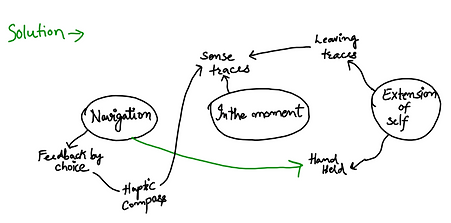
Embodied design for social hiking
Designing for enhancing 'In-the-Moment' experiences, navigation, and self-extension
Overview
This project focuses on individual cognitive perspectives in hiking, exploring how embodied design can bring a more immersive experience for hikers. Through an ethnographic study, we identified key themes for immersion and built wearable prototypes with different materials for haptic navigation.
Year
June 2023
Team/
Bhakti Moghe Euodia Louis Setiono Oei
Eve Martina Lange Md Habibur Rahman Muneeb Sarfraz Yuanxi Jiang
My Role/
UX Researcher Interaction Designer
Research objectives:
-
Observe the hiking practice and identify the concept "in-the-moment".
-
Understand challenges and design oppotunities.
-
Develop prototypes and test in iterations
Methodology: Observations, Interviews & Thematic Analysis
-
Ethnographic Observations & Preliminary Study
-
Conducted two hiking observations on Linnaeus’ Danmark Trail (11-12km, 20 hikers) and Gamla Trail (7km, 10 hikers) to examine real-world navigation behaviors and social interactions.
-
Observed how hikers interact with physical and digital navigation tools, including maps, signposts, and mobile applications.
-
Documented decision-making strategies for route selection, collaborative wayfinding, and adjustments based on terrain difficulty and environmental factors.
-
Recorded hikers' real-time reactions to unexpected trail diversions and observed how they adapted to uncertainty.
-
-
In-depth interviews with hike leader and participants.
-
Focused on hiking motivations, wayfinding preferences, and distractions.
-
Key insight: Physical signposts are preferred over digital maps, as they keep hikers more alert and engaged.
-
-
Thematic Analysis & In-Depth Findings
-
Structured qualitative coding was used to analyze interview transcripts and observation notes.
-
-
Identified three key themes with deeper insights:
-
In-the-Moment Awareness: Hikers engaged more deeply with their surroundings when they relied on bodily cues rather than digital screens. Those who used digital maps often felt disconnected from their immediate environment.
-
Navigation & Decision-Making: Participants relied on a mix of trail markers, physical memory, and group discussions. Digital aids were often secondary and used only when uncertainty arose.
-
Extension of Self & Tool Usage: Hikers intuitively adapted objects (e.g., sticks, ropes) to aid in navigation, stability, and interaction with the terrain. This inspired the wearable haptic device design.
-

First and second observations’ thematic analysis
Design Process & Prototyping
Bodystorming & Ideation:
-
Conducted a bodystorming workshop with 20 participants, simulating hiking conditions and observing navigation behavior.
-
Assigned three embodied interaction prompts:
-
Navigation Without Screens: How do hikers rely on bodily movement and environmental cues without digital aids?
-
In-the-Moment Awareness: How do physical actions enhance or disrupt immersion in the hiking experience?
-
Extension of Self: How do hikers naturally use objects as bodily extensions for navigation and balance?
-
-
Encouraged participants feel free to use natural objects (sticks, stones, ropes) during the hike. Observe behavior.


Bodystorming Analysis

Connecting three prompts to find ideas

Mind Mapping
Prototyping:
We built three alternatives:
-
Haptic Feedback Device (Vibration Motor):
-
Provides vibration cues to guide navigation.
-
Users receive increasing vibration intensity when moving off-trail.
-
Prioritizes intuitive, non-visual feedback.
-
-
Compass-Like Device (Rotational Movement):
-
Uses servo motors to point toward the correct path.
-
Mimics a physical compass for intuitive wayfinding.
-
Provides directional guidance while preserving immersion.
-
-
Visual Feedback (LED Stick):
-
Changes brightness based on navigation accuracy.
-
Minimized due to sunlight visibility issues.
-
Evaluation & Findings
Testing, Iteration & User Feedback
-
Three rounds of field testing conducted with regular hikers and experienced trail guides to refine the prototype.
-
Wizard of Oz method used to simulate device behavior, ensuring controlled evaluation of feedback mechanisms.
-
Participants navigated predefined trails using prototypes, and feedback was collected on usability, comfort, and interaction intuitiveness.
Iteration Process & Refinements
Iteration 1: Haptic navigation preference
-
Conducted on a controlled hiking trail with 5 participants.
-
Identified haptic intensity inconsistencies—some feedback was too weak, while others were overwhelming.
-
Adjusted vibration frequency and intensity levels to provide clearer yet non-intrusive navigation guidance.
-
Feedback: Users found vibrations useful but needed better differentiation between left and right turns.

Alternative 1: Controlled the vibration using potentiometer

Sketch of how the alternative 1 - vibrating device works

Alternative 2: The potentiometer was used to control the movement or rotation of the object

Sketch of how alternative 2 (compass-like) device works

Alternative 3: LED was positioned at the top end of the stick

Sketch of how alternative 3 (visual feedback) works
Iteration 2: Vibration selection
-
Conducted with 8 participants on an extended hiking route.
-
Switched from a clip-on device to a wristband format, improving stability and ease of use.
-
Adjusted material to lightweight, water-resistant fabric for durability in various weather conditions.
-
Feedback: Users reported higher comfort and easier interaction, but some suggested finer control over vibration intensity.

Alternative 1 - Haptic Feedback Using Vibration Motor (2 variants)
Left: variant 1 with ERM vibration motor, Right: variant 2 with LRA

Alternative 2 - Compass-Like device using Rotational Movement (Servos)
Iteration 3: Wearability and carry preference
-
Conducted testing with 10 experienced hikers.
-
Feedback: Focus on the autonomy, refine the prototype to fit the preferred carry mode.

From left: Variant 3, variant 2, variant 1

Sketch of the final prototype (variant 1) works. All variants have the same functions, but just slightly different shapes.
Based on user feedback, the final wearable device integrated:
✅ Haptic Feedback (Vibration Motor) for subtle guidance.
✅ Customizable feedback intensity to understand direction.
✅ Wristband or attachable form for hands-free and enhance autonomy.
Future Work:
-
AI-driven haptic navigation. Explore how AI can dynamically adjust haptic feedback based on terrain difficulty, user behavior, and environmental conditions. This could enhance personalization and responsiveness in real-time navigation.
-
Explore oppotunities with different materials and properties. Understand how different materials shape experience.
-
Study the long-term impact on navigation habits and immersion. Conduct extended field studies to examine how prolonged use of haptic navigation influences hikers' spatial awareness, reliance on digital aids, and overall immersion in nature.

